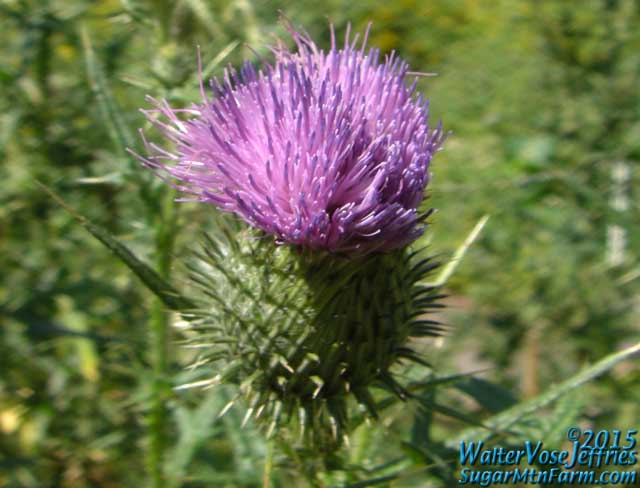
Purple Thistle (Silybum marianum)
I used to worry about thistles and burdocks. That was back before our pigs. The thistles because while they are beautiful they are also extremely painful to brush up against. The burdock because they use our sheep to migrate, ruining the wool.
But all that changed with the pigs. We have virtually no thistles or burdock in our fields now because it turns out our pigs love both. So much so that they’ve wiped out the burdock and thistle populations within their fenced pastures. New small ones will start growing from blown in seed but quickly get devoured.
Turns out these prickly plants must taste like candy, to pigs. They chow them down. Ow! My tongue and lips tingle at the thought but the pigs apparently are immune to what I find so stinging.
Both of these are plants with deep tap roots. I suspect they are bringing up nutrients to the surface which the pigs need in their diet. Those then end up in the leaves, flowers, stalk and the tap roots which the pigs root up and eat. This was not the plant’s plan. Sits fine with me though.
Unlike the sunchokes, thistles and burdock do not spread well by root fragmentation so having their roots torn up is a terminal process. They need to go to seed to continue to the next generation of the game.
So, how does one perpetuate a useful plant like this…provided you want to do so? The trick is reserves, annual rotation over grand rotation and grazing sequences. Timing is everything.
Between pasture paddock double fence lines are strips of reserve vegetation with fruit trees and other forages. These are seed sources. Most of the pigs can’t get in there so as to protect the apple, pear, nut and other trees as well as comfrey, garlic and such which then spread out into the pastures. These are beneficial plants, some medicinal, other falling forage crops, that need protection from the livestock. Sheep for example are absolutely evil on fruit trees. One look from a ewe and an apple may die. Well, maybe not quite that bad but sheep and horses love to strip off the sweet bark.
Couple the reserve areas with a grand rotation that shifts the primary fields in use over a larger area such that some fields are getting rested. This allows us to keep a larger area of pasture available for quick expansion as well as being ready for late fall grazing when the field forages fade and we need more acres per pig. It is easier to clear back the trees and fence in large chunks than to add just a little each year. The grand rotation utilizes this and keeps all of that area open and ready to shift into use.
Lastly, grazing cycle timed to the growth flowering and seed cycles of forages is critical so as to utilize self-seeding. Seed is cheaper than feed. Self-seeding is 100x cheaper than seed.
Reserves – Grand rotations – Timing. These work together to maximize forage qualities for grazing all species of livestock and create wild habitats for both flora and fauna.
Outdoors: 82°F/67°F Sunny
Tiny Cottage: 69°F/62°F
Daily Spark: Tom swiftly turned into a candy shop and left the door a jar.





